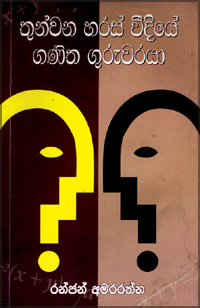Narratives as investigative tragi-comedy creations
Professor Sunanda Mahendra
 FICTION:
The eight short stories embedded in the collection titled, Tunveni
Harasvidiye Ganita Guruvaraya (The Maths Teacher of the Third Cross
Street), a Surasa book, by Ranjan Amararatne are presumably forgotten by
the critics of the day, and could well be regarded as variant forms of
narratives from the existing pattern of short stories commonly
encountered in the Sinhala literary scene. FICTION:
The eight short stories embedded in the collection titled, Tunveni
Harasvidiye Ganita Guruvaraya (The Maths Teacher of the Third Cross
Street), a Surasa book, by Ranjan Amararatne are presumably forgotten by
the critics of the day, and could well be regarded as variant forms of
narratives from the existing pattern of short stories commonly
encountered in the Sinhala literary scene.
This is observable from two points of view; firstly, the author has a
plotted woven narrative packed with events to present, which is more of
an investigative nature and closer to the realities of life.
Secondly, they delve deeply into the inner human links and bonds
transcending the barriers of mere conventional story telling depicting
the complexities of human experiences from that reality in the form of
fantasies and absurdities.
 Amararatne
takes no special care for long drawn descriptions of events, but makes
the characters speak their hearts out without being too formal and
inhibitive. In his creativity, the writer outlines six concepts of his
own as guidelines (influenced by Edward Carpenter, a critic of
narratives): Amararatne
takes no special care for long drawn descriptions of events, but makes
the characters speak their hearts out without being too formal and
inhibitive. In his creativity, the writer outlines six concepts of his
own as guidelines (influenced by Edward Carpenter, a critic of
narratives):
(1) study of characters
(2) observation of events
(3) internal monologue
(4) introspection
(5) formation of imagery
(6) creating fantasies.
Whether you believe in the critical theories or not, as laid down, it
is the scrutiny of the narratives that matter here. A writer may adhere
to various forms of theoretical concepts, but it is the reader who
discriminates the actual aesthetic value underlying the creation that
lay before him.
Assassination
The first story Paminillak (A Complaint) happens in a police station
where a certain muddle-headed deranged-minded woman sits opposite an old
police officer trying to lodge an entry regarding her side of the event
of an assassination.
She came all along to the Police to expose the assassination of her
unmarried man, and comes out with a bundle of harangues about him and
his friends who spoiled him since she had come to know him.
The police officer is at a fix to understand what she says, but feels
that she has something to express beyond his normal encounters in his
day-to-day functions. But more he tries to understand her, more he
becomes puzzled. She confesses that she had known him and suffered due
to him.
Interlocution
In a turn of events during the expression she says that she
nevertheless loves the man and feels that she cannot resist seeing him.
What happens in the interlocution is notable. As the dialogue ensues,
the police officer finds from her that she had not actually killed the
man, but it is a mere fantasy of her own reverberating in her mind that
gives expression in the most absurd form possible.
As a result, the police officer finds that his duty is challenged,
and there is no way out but to close the entry book reflecting on the
dilemma, nothing but an inner expression impossible to be written in
simple entry form.
The narrative rests on two layers; firstly on the innocence of the
woman which could be traced not by a police officer but by a
psychiatrist, and secondly the nature of the human tragedies that should
be perceived via fantasies.
The impossibility of her mental stress to be written in a police
entry seems the latent theme. This narrative perhaps may give way to the
creation of a good one-act play with a touch of the theatre of the
absurd.
The story titled Eyat Geheniyak (She is also a Woman) revolves round
the life of a woman married to a lethargic ageing man supposed to be a
traditional vernacular physician who has inherited quite a lot of paddy
lands but fails to cultivate them owing to his lethargy.
But the woman, being more active, wants to cultivate them in keeping
with the customs of the culture and gets the collective functions
fulfilled through the villagers.
What happens in the process is that she meets one of the handsome
young men, who toils hard in the field and is attracted by him to the
point that she sees the sky of a difference between the husband and the
young man.
She in fact goes ahead to be with him, but when he requests her to be
his wife for the rest of the life leaving aside the lethargic old man,
she reluctantly moves away from him implying that she prefers to lead a
happy legitimate life of a wife and a mother despite her grievances and
expects one more by the young man.
The legitimate husband comes to know about the incident, pardons her
when she openly declares her plight. She feels that she had disobeyed
the husband and seeks to be pardoned.
The narrative is reminiscent of some of the age old folktales where
the inner nature of the motherhood is displayed as the most vibrant
theme despite other trivial intricacies of the uncommon behaviour on the
part of the humans from a more modern standpoint. For the modern reader,
the narrative may look more of a fable or a parable.
Conflict
Avurudu Sadaya (New Year Party) and the title story Ganita Guruvaraya
(Maths Teacher) are more of the tragi-comedy type. The most significant
factor is the conflict of the mind and the outer world where the latter
wins over the inner factors.
The first part of the narrative introduces to the reader the stance
of a Maths teacher (or he may be called a teacher of arithmetic as it
was known those days) who despite his talent is removed from the
teaching profession as punishment presumably for his over-drunken
nature.
He finds it difficult to exist in his own manner giving vent to his
desires and habit formations. As such, he begins to give tuition to
various types of students ranging from young girls and boys to adults in
the government offices.
But his drunken nature exceeds over the time, and he eventually steps
into one of the taverns to find that workers are on strike clamouring
for the removal of the mayor or some high calibred official in the
administrative strata.
The workers take no heed of the dignity of the Maths teacher and
disregard him as an unwanted person when he invites them for a drink.
But he sees no reason as to why they reject him. But this too comes to
be known as time goes on.
Political investigation
Then he finds that his wife is in good books with the authorities,
which harm the workers’ movement. In a tragic-comedy level of behavior
he finds that his wife, despite her pious outer conduct, is misbehaving
with the mayor on a day when he arrives home rather early.
He steals the cloths, the money and the pistol of the high official
and gets on to a table and addressing them loudly shows the workers in
the tavern about his latent talent of political investigation. But
unfortunately the reader finds that the man is killed by an unknown
person with the very same pistol he steals from the man who was with his
wife.
In Avurudu Sadaya, a man wants to invite a certain good-hearted man
whom he thought as the most fitting character to be the guest for the
New Year feast.
When everything was arranged to see him, the man seems to be missing
from the place of stay, as he is known to be in the hospital gone for
treatments for a certain sickness caused as a result of
over-drunkenness.
The disillusionment is seen deadly from his point of view and feels
that an inauspicious factor had befallen. Written in a readable prose,
the narratives rest on various levels of socio political and individual
traits with reference to love, sex and marriage.
[email protected] |

